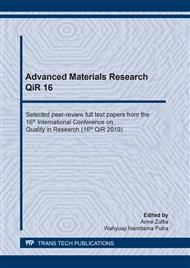[1]
W. Chen and J. Liang, A Review of Battery for Vehicle Applications The Lithium-Ion on Electric and Beyond,, Energy Procedia, vol. 158, p.4363–4368, (2019).
DOI: 10.1016/j.egypro.2019.01.783
Google Scholar
[2]
G. Zubi, R. Dufo-López, M. Carvalho, and G. Pasaoglu, The lithium-ion battery: State of the art and future perspectives,, Renew. Sustain. Energy Rev., vol. 89, p.292–308, (2018).
DOI: 10.1016/j.rser.2018.03.002
Google Scholar
[3]
G. Zhang, Y. Chen, Y. Chen, and H. Guo, Activated biomass carbon made from bamboo as electrode material for supercapacitors,, Mater. Res. Bull., vol. 102, p.391–398, (2018).
DOI: 10.1016/j.materresbull.2018.03.006
Google Scholar
[4]
K. Sharma, A. Arora, and S. K. Tripathi, Review of supercapacitors : Materials and devices,, vol. 21, no. October 2018, p.801–825, (2019).
Google Scholar
[5]
B. Li, H. Zhang, D. Wang, H. Lv, and C. Zhang, Agricultural waste-derived activated carbon for high performance lithium-ion capacitors,, RSC Adv., vol. 7, no. 60, p.37923–37928, (2017).
DOI: 10.1039/c7ra06680e
Google Scholar
[6]
C. Liu et al., High energy and power lithium-ion capacitors based on Mn3O4/3D-graphene as anode and activated polyaniline-derived carbon nanorods as cathode,, Chem. Eng. J., vol. 370, p.1485–1492, (2019).
DOI: 10.1016/j.cej.2019.04.044
Google Scholar
[7]
H. Li et al., Constructing surface-driven lithium ion storage structure for high performance hybrid capacitor,, Electrochim. Acta, vol. 299, p.163–172, (2019).
DOI: 10.1016/j.electacta.2018.12.172
Google Scholar
[8]
Q. Lu et al., Porous activated carbon derived from Chinese-chive for high energy hybrid lithium-ion capacitor,, J. Power Sources, vol. 398, no. June, p.128–136, (2018).
DOI: 10.1016/j.jpowsour.2018.07.062
Google Scholar
[9]
J. Zhang, J. Wang, Z. Shi, and Z. Xu, Electrochemical behavior of lithium ion capacitor under low temperature,, J. Electroanal. Chem., vol. 817, p.195–201, (2018).
DOI: 10.1016/j.jelechem.2018.04.014
Google Scholar
[10]
A. R. Aref, S.-W. Chen, R. Rajagopalan, and C. Randall, Bimodal porous carbon cathode and prelithiated coalesced carbon onion anode for ultrahigh power energy efficient lithium ion capacitors,, Carbon N. Y., (2019).
DOI: 10.1016/j.carbon.2019.05.074
Google Scholar
[11]
N.-W. Li et al., Graphene@hierarchical meso-/microporous carbon for ultrahigh energy density lithium-ion capacitors,, Electrochim. Acta, vol. 281, p.459–465, (2018).
DOI: 10.1016/j.electacta.2018.05.147
Google Scholar
[12]
L. Ye et al., A high performance Li-ion capacitor constructed with Li4Ti5O12/C hybrid and porous graphene macroform,, J. Power Sources, vol. 282, p.174–178, (2015).
DOI: 10.1016/j.jpowsour.2015.02.028
Google Scholar
[13]
R. Farzana, R. Rajarao, B. Ramachandra, and V. Sahajwalla, Performance of an activated carbon supercapacitor electrode synthesised from waste Compact Discs ( CDs ),, J. Ind. Eng. Chem., vol. 65, p.387–396, (2018).
DOI: 10.1016/j.jiec.2018.05.011
Google Scholar
[14]
A. G. Pandolfo and A. F. Hollenkamp, Carbon properties and their role in supercapacitors,, vol. 157, no. 1, p.11–27, (2006).
Google Scholar
[15]
R. F. Susanti, A. A. Arie, H. Kristianto, M. Erico, G. Kevin, and H. Devianto, Activated carbon from citric acid catalyzed hydrothermal carbonization and chemical activation of salacca peel as potential electrode for lithium ion capacitor's cathode,, Ionics (Kiel)., (2019).
DOI: 10.1007/s11581-019-02904-x
Google Scholar
[16]
K. Zheng et al., The porous carbon derived from water hyacinth with well-designed hierarchical structure for supercapacitors, vol. 366. (2017).
Google Scholar
[17]
A. A. Arie, H. Kristianto, M. Halim, and J. K. Lee, Synthesis and modification of activated carbon originated from Indonesian local Orange peel for lithium ion Capacitor ' s cathode,, p.1331–1342, (2017).
DOI: 10.1007/s10008-016-3445-7
Google Scholar
[18]
X. Gao, C. Zhan, X. Yu, Q. Liang, R. Lv, and G. Gai, A High Performance Lithium-Ion Capacitor with Both Electrodes Prepared from Sri Lanka Graphite Ore,, (2017).
DOI: 10.3390/ma10040414
Google Scholar
[19]
Y. Gao et al., Porous carbon made from rice husk as electrode material for electrochemical double layer capacitor,, Appl. Energy, vol. 153, p.41–47, (2015).
DOI: 10.1016/j.apenergy.2014.12.070
Google Scholar
[20]
R. Fu, X. Zhou, H. Fan, D. Blaisdell, A. Jagadale, and X. Zhang, Comparison of Lithium-Ion Anode Materials Using an Experimentally Verified Physics-Based Electrochemical Model,, p.1–20.
DOI: 10.3390/en10122174
Google Scholar
[21]
D. Streich, M. He, M. Mendez, F. F. Chesneau, P. Nov, and E. J. Berg, Decomposition of LiPF 6 in High Energy Lithium-Ion Batteries Studied with Online Electrochemical Mass Spectrometry,, vol. 163, no. 6, p.1095–1100, (2016).
DOI: 10.1149/2.0981606jes
Google Scholar


